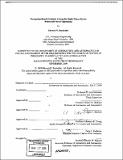| dc.contributor.advisor | R. John Hansman. | en_US |
| dc.contributor.author | Bachelder, Edward N. (Edward Nelson), 1963- | en_US |
| dc.contributor.other | Massachusetts Institute of Technology. Dept. of Aeronautics and Astronautics. | en_US |
| dc.date.accessioned | 2011-03-24T20:15:41Z | |
| dc.date.available | 2011-03-24T20:15:41Z | |
| dc.date.copyright | 2000 | en_US |
| dc.date.issued | 2000 | en_US |
| dc.identifier.uri | http://hdl.handle.net/1721.1/61846 | |
| dc.description | Thesis (Ph.D.)--Massachusetts Institute of Technology, Dept. of Aeronautics and Astronautics, 2000. | en_US |
| dc.description | Includes bibliographical references (p. 144-146). | en_US |
| dc.description.abstract | Helicopter flight using night-vision devices (NVDs) is difficult to perform, given evidence by the high accident rate associated with NVD flight compared to day operation. A mishap analysis of NVD-related helicopter accidents was conducted which found approximately 70% of the accidents attributable to pilot misperception of the flight environment, with the most frequently misperceived states being spatial in nature and in the hover regime. While hardware changes such as increasing the field of view or image resolution may alleviate some of the problems, it is unlikely that they will address all of the perceptual issues. The approach proposed in this thesis is to augment the NVD image with synthetic cueing, whereby the cues would emulate position and motion in an ecological fashion and appear to be actually occurring in physical space on which they are overlaid. Synthetic cues allow for selective enhancement of perceptual state gains to match the task requirements. The perceptual gains examined were aircraft positional error along the three translational axes. A hover cue set was developed based on an analogue of a physical target used in a flight handling qualities tracking task, a perceptual task analysis for hover, and fundamentals of human spatial perception. The display was implemented on a simulation environment, constructed using a virtual reality device, an ultrasound head-tracker, and a fixed-base helicopter simulator. Seven highly trained helicopter pilots were used as experimental subjects and tasked to maintain hover in the presence of aircraft positional disturbances while viewing a synthesized NVD environment and the experimental hover cues. The simulation employed a number of unique techniques that enabled identification of visual perception and division-of-attention effects. Measures of hover performance and subjective ratings were collected, and frequency analysis was used to measure system (i.e., pilot/display/vehicle suite) stability and bandwidth. Significant performance improvements in NVD flight were observed when using synthetic cue augmentation. Subjective ratings showed longitudinal control to be more difficult than in the other axes for both single and multi-axis control. This thesis demonstrates that artificial magnification of perceptual states through synthetic cueing can be an effective method of improving night-vision helicopter hover operations. | en_US |
| dc.description.statementofresponsibility | by Edward N. Bachelder. | en_US |
| dc.format.extent | 146 p. | en_US |
| dc.language.iso | eng | en_US |
| dc.publisher | Massachusetts Institute of Technology | en_US |
| dc.rights | M.I.T. theses are protected by
copyright. They may be viewed from this source for any purpose, but
reproduction or distribution in any format is prohibited without written
permission. See provided URL for inquiries about permission. | en_US |
| dc.rights.uri | http://dspace.mit.edu/handle/1721.1/7582 | en_US |
| dc.subject | Aeronautics and Astronautics. | en_US |
| dc.title | Perception-based synthetic cueing for night-vision device rotorcraft hover operations | en_US |
| dc.title.alternative | Perception-based synthetic cueing for NVD rotorcraft hover operations | en_US |
| dc.type | Thesis | en_US |
| dc.description.degree | Ph.D. | en_US |
| dc.contributor.department | Massachusetts Institute of Technology. Department of Aeronautics and Astronautics | |
| dc.identifier.oclc | 48384652 | en_US |
